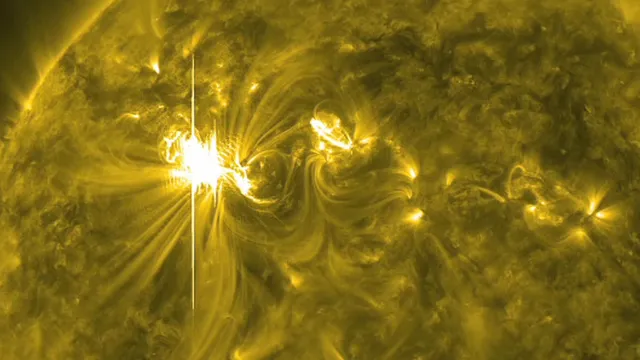
Powerful solar flare causes widespread radio blackout
2025-02-25 04:32- On February 23, 2025, a powerful X2.0-class solar flare erupted from sunspot AR 4001 on the Sun's northwestern limb.
- The flare caused an R3-rated radio blackout across parts of the Pacific Ocean, leading to a degradation or loss of high-frequency radio signals.
- Such solar activities are rare but can disrupt various technologies, and further activity is predicted over the coming days.
Express your sentiment!
Insights
On February 23, 2025, a significant solar flare was unleashed by the Sun, resulting in a radio blackout across portions of the Pacific Ocean. The US National Oceanic and Atmospheric Administration (NOAA) identified the flare as an X2.0-class eruption that occurred at approximately 7:30 PM GMT. The eruption originated from a sunspot nearing the Sun's northwestern limb, designated as sunspot AR 4001. Solar flares are powerful bursts of radiation that can last from a few minutes to several hours, disrupting various forms of communication and navigation technologies. This specific event, categorized as R3, brought strong impacts including a wide area blackout of high-frequency (HF) radio communication. Users in the affected regions experienced temporary degradation or complete loss of signal due to the solar activity. The NOAA emphasized that while solar flares of this magnitude are uncommon, their occurrences can disrupt not only radio communications but also power grids, navigation systems, satellites, and potentially affect astronauts in space. The effects on communication signals are rated on a scale from R1 to R5, and the designation of R3 indicates strong effects with a significant impact on the sunlit side of Earth. The agency also mentioned the likelihood of minor to moderate solar flare activity continuing throughout the week, with the potential for additional R3 or greater events predicted from February 25 to February 27. During this time, the Sun is at its peak of an approximately 11-year activity cycle, which suggests that increased solar activity and flares will become more common. Researchers and scientists closely monitor these solar events, as they can pose risks to various technologies and infrastructures that are integral to modern society. Understanding and predicting these solar phenomena is crucial in mitigating the potential negative consequences that arise from such solar eruptions.
Contexts
Solar flares are powerful bursts of radiation that can have significant effects on various sectors of technology, particularly communication systems. These eruptions occur on the surface of the sun and release energy that travels through space. When the radiation reaches Earth, it can disrupt the ionosphere, a layer of charged particles that plays a crucial role in radio wave propagation. The disruptions can lead to degraded or lost radio signals, affecting aviation, maritime operations, and emergency services, among others. Understanding this impact is essential for maintaining reliable communication in today’s technologically driven world. The impact of solar flares on communication systems is multifaceted, influencing both terrestrial and satellite communications. High-frequency (HF) radio communications, which rely on the reflection of radio waves off the ionosphere, are especially vulnerable. When solar flares occur, the increased ionization in the atmosphere can lead to signal absorption, resulting in communication blackouts. These disruptions can range from minor interruptions to significant outages lasting hours or even days, depending on the intensity of the solar flare. Satellite communication systems are also at risk, as solar flares can increase radiation levels in space, potentially damaging the satellites’ electronic components and causing temporary or permanent loss of service. Furthermore, solar flares can interfere with Global Navigation Satellite Systems (GNSS), such as GPS. The ionospheric disturbances caused by solar activity can introduce errors in positioning and navigation data, which can have serious implications for sectors relying on precise location information, including aviation, maritime navigation, and various ground-based transportation systems. As societies become increasingly reliant on these technologies, the need for real-time monitoring of solar activity and its potential impacts on communication systems becomes more critical. To mitigate the risks associated with solar flares, ongoing research is essential. Developing predictive models that can forecast solar activity and its potential effects on communication systems will enable operators to implement strategies to safeguard infrastructure. Moreover, investing in robust technologies that can withstand the effects of such cosmic events will be crucial for maintaining the reliability of communication systems in the face of solar activity. As we advance into an era where technology is deeply intertwined with our daily lives, understanding and preparing for the impact of solar flares on communication systems should remain a priority for researchers and policymakers alike.